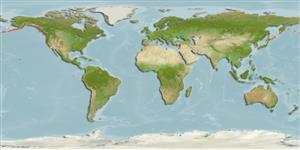Environment: milieu / climate zone / profondeur / distribution range
Écologie
marin démersal; profondeur 0 - 12 m (Ref. 2850). Temperate; 66°N - 32°N
Eastern Pacific: Bering Sea coast of Alaska to southern California, USA.
Taille / Poids / Âge
Maturité: Lm ? range ? - ? cm
Max length : 20.0 cm TL mâle / non sexé; (Ref. 2850)
Description synthétique
Clés d'identification | Morphologie | Morphométrie
Épines dorsales (Total) : 69 - 78; Rayons mous dorsaux (Total) : 0; Épines anales: 2 - 3; Rayons mous anaux: 40 - 50. Caudal rounded; pectorals very small (Ref. 6885). Olive green to olive dark brown dorsally, yellow to green ventrally, frequently with darker markings on side, small white spots sometimes evident along midside, 4 light and dark streaks reaching back and down from eyes, fins green to brown tinged with yellow (Ref. 6885).
Found under rocks in intertidal areas and to about 12 m depth (Ref. 2850). Feeds on crustaceans, and red and green algae (Ref. 6885).
Life cycle and mating behavior
Maturité | Reproduction | Frai | Œufs | Fécondité | Larves
Eschmeyer, W.N., E.S. Herald and H. Hammann, 1983. A field guide to Pacific coast fishes of North America. Boston (MA, USA): Houghton Mifflin Company. xii+336 p. (Ref. 2850)
Statut dans la liste rouge de l'IUCN (Ref. 130435: Version 2025-1)
Menace pour l'homme
Harmless
Utilisations par l'homme
Outils
Articles particuliers
Télécharger en XML
Sources Internet
Estimates based on models
Preferred temperature (Réf.
123201): 4.7 - 13, mean 8.2 °C (based on 581 cells).
Phylogenetic diversity index (Réf.
82804): PD
50 = 1.0000 [Uniqueness, from 0.5 = low to 2.0 = high].
Bayesian length-weight: a=0.00389 (0.00180 - 0.00842), b=3.12 (2.94 - 3.30), in cm total length, based on all LWR estimates for this body shape (Ref.
93245).
Niveau trophique (Réf.
69278): 2.6 ±0.20 se; based on food items.
Résilience (Réf.
120179): Milieu, temps minimum de doublement de population : 1,4 à 4,4 années (Preliminary K or Fecundity.).
Fishing Vulnerability (Ref.
59153): Low vulnerability (10 of 100).
🛈
